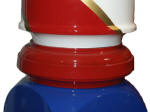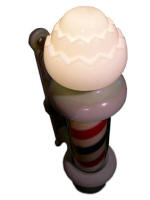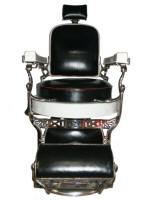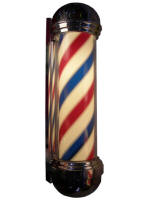There are a number of
items in the Antique Warehouse Collection related to the Barber Shop
category, all of which will be focused on in this months Featured
Item(s). The majority of the items in the collection are
barber poles and barber chairs, while there are a few other
accessories and books in the collection as well.
Barber Poles, likely one of the most recognizable trade symbols,
have evolved from simple, "bloodstained white cloth dressings which
hung to dry outside barbers' doorways centuries ago when barbers
were referred to as 'Chirurgens.' In those times, academic
physicians and barbers alike shared some medical duties and belonged
to the same surgeons guild." Many have heard the stories that
barbers performed surgical procedures, bloodletting, and tooth
extraction, in addition to cutting hair and shaving their clients.
Eventually, the two guilds were split by King George II in 1745,
requiring surgeons to display red and white poles while barbers
displayed blue and white poles. By the 1870's in America the red
stripe found its way back onto barber poles, as a "wave of
patriotism surrounded the Centennial of 1776." From the 1890's
up through 1915, a number of poles were produced in a variety of
shapes and sizes. The traditional wood pole made way for sheet
metal and cast iron poles, followed by the long lasting porcelain
covered cast iron poles, which eventually became the standard.
The other major category related to barber shop items, which are
highly collectable, are barber chairs. Not much is known about
the history of barber chairs, but there are four main era's in which
the style of chairs has changed. The four era's include the
"Mid-1800's Period"
(1850-1880), "Late Victorian Period"
(1880-1900), "Transitional Period" (about 1895-1915), and the "20th
Century" (1915-1950). Before the 1850's, most barber chairs
were not so different than a typical dinning room chair. They
may have had fixed position head rests, or have been slightly
taller, but for the most part, were not that dissimilar.
From the 1850's on, barber chairs did start to show more mechanical
functionality, being made specifically for barber shops, which
starts the "Mid-1800's Period." These chairs usually were
crafted out of wood, with backs that would recline a few degrees,
and by the end of the period, would recline fully. However
these chairs did not raise or lower, and did not swivel. Many
of the chairs also had some sort of foot stool.
The "Late Victorian Period" saw many advanced changes. While
the chairs were still made from wood, they were built with
hydraulics, allowing them to raise and lower, along with being able
to swivel
360 degrees, in addition to being able to fully recline. This era of
chair started to look very elegant as well, being, "plush covered
and highly ornate with wood, fabric, and trim materials of a wide
selection. Style was important during this period as most
chairs had fancy hand carvings or similar embellishments."
The "Transitional Period" saw changes in the types of materials used
to fabricate the base of the chairs, changing from wood to heavy
duty porcelain covered cast iron. While the chair itself would
still have been constructed out of wood with all of the amenities of
the previous period.
The "20th Century" model chairs found manufacturers producing all
porcelain covered cast iron chairs and bases. These
manufacturers learned that they could produce all porcelain cover
cast iron chairs for less than the cost of wooden chairs.
However, it took quite some time for the chairs to become popular,
as the barbers liked their wooden chairs. Eventually with the
threat of communicable disease breakouts in that period, customers
started demanding the clean, white, washable look of porcelain.
There are a number of different collectable antique accessories and
other items associated with barber shops, including backbars,
display cases, sinks, coat racks, razors, scissors, shaving mugs,
barber bottles, combs, signs, advertising, and the list goes on and
on. Several of these items are included in the Antique
Warehouse Collection. The entire Barber Shop collection can be viewed
by clicking on any of the
images below.
Jones, Christian R. Barber Shop History & Antiques.
Schiffer, 1998.
|









